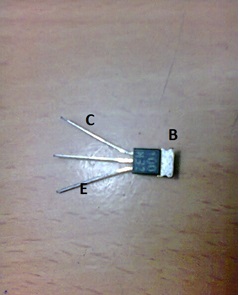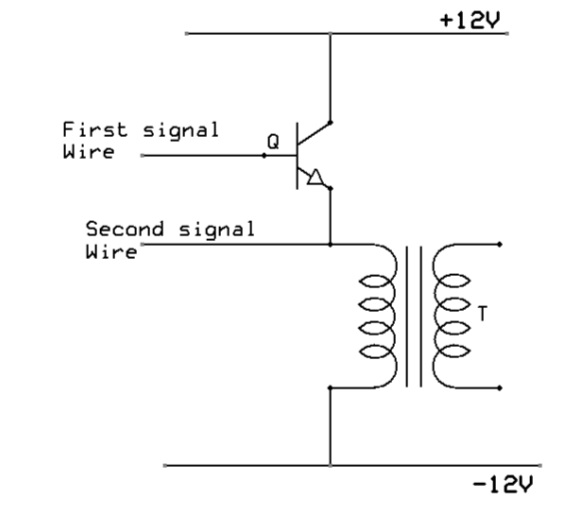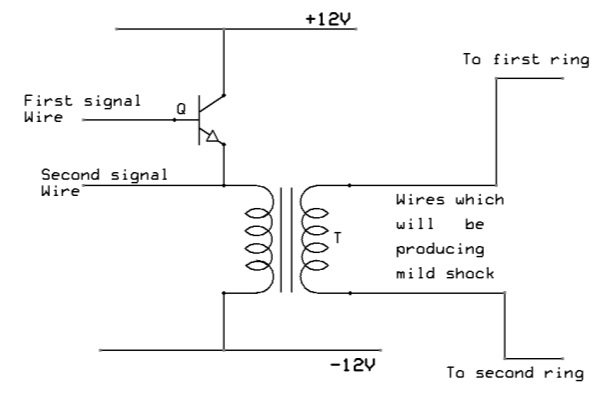Aim: To make an alarm battery which will awake you at the correct given time.
Material required: Transformer, NPN transistor, connecting wire, alarm watch, 12v battery.
Things you should know well:
Transformer
A transformer is a static electrical device that transfers energy by inductive coupling between its winding circuits. A varying current in the primary winding creates a varying magnetic flux in the transformer’s core and thus a varying magnetic flux through the secondary winding. This varying magnetic flux induces a varying electromotive force (emf) or voltage in the secondary winding.
Transformers range in size from thumbnail-sized used in microphones to units weighing hundreds of tons interconnecting the power grid. A wide range of transformer designs are used in electronic and electric power applications. Transformers are essential for the transmission, distribution, and utilization of electrical energy.
Alarm clock
An alarm clock is a clock that is designed to wake a person at a specific time. The primary use of these clocks is to awaken people from their night’s sleep or short naps; they are sometimes used for other reminders as well. Some use sound, some use light, and some use sensors to identify when a person is in a light stage of sleep, in order to avoid waking someone when they’re deeply asleep, which causes tiredness, even if the person has had adequate sleep. To stop the sound or light, a button or handle on the clock is pressed; but most clocks automatically stop the alarm if left unattended long enough. A classic analog alarm clock has an extra hand or inset dial that is used to specify the time at which to activate the alarm.
NPN transistor
NPN is one of the two types of bipolar transistors, consisting of a layer of P-doped semiconductor (the “base”) between two N-doped layers. A small current entering the base is amplified to produce a large collector and emitter current. That is, when there is a positive potential difference measured from the emitter of an NPN transistor to its base (i.e., when the base is high relative to the emitter) as well as positive potential difference measured from the base to the collector, the transistor becomes active. In this “on” state, current flows between the collector and emitter of the transistor. Most of the current is carried by electrons moving from emitter to collector as minority carriers in the P-type base region. To allow for greater current and faster operation, most bipolar transistors used today are NPN because electron mobility is higher than hole mobility.
Procedure:
1.Take Transformer in your hand which converts 220v to 12v or 12v to 220v.

2.Identify the wire by passing the 12V current in the first pair wire if the voltage in the second wire is 0.65v then change the wire then you can find out that it is coming 2230v.
3.Take the watch and de assemble it. You can now be able to see the spring like structure that will
be your signal wire.

4.Connect first wire in the positive terminal of the battery and the second wire in the spring.

5.Take the transistor which should be NPN. Connect the transistor as shown in the diagram.



6.Connect the wire to the signal wire.
7.The two terminals of the transformer which is left black till now will be connected to the two different wires then to the two different metal sheet or metal ring or we can say conducting metals.
8.Set the time in the clock.
9.When the alarm will ring you will get the mild electric shock.
10.Total electrical circuit is shown in circuit diagram tab.
How to use it:
This is not so complicated that you cannot so it. It is very easy and every one of you does it. You have to set the time and when the alarm time will come then you will get the mild shock that will wake you up daily in the morning and then you can be able to do whatever work you want to do.
There is no doubt that you will miss the work you have to do in the morning. Set the time and it will wake you up as you want.
Advantage:
1.Eco friendly: No noise pollution.
2.Energy saver
3.Work very quickly.
Disadvantages:
1.If something goes wrong your watch may be damaged.
2.Only that person can wake up who has wear this machine.
3.Electric shock is not good for health so never try to increase the voltage range.
4.Never use the charger/ adapter or current from any source. Always use battery.
Project Source Code
Circuit Diagrams
Filed Under: Electronic Projects



Questions related to this article?
👉Ask and discuss on EDAboard.com and Electro-Tech-Online.com forums.
Tell Us What You Think!!
You must be logged in to post a comment.